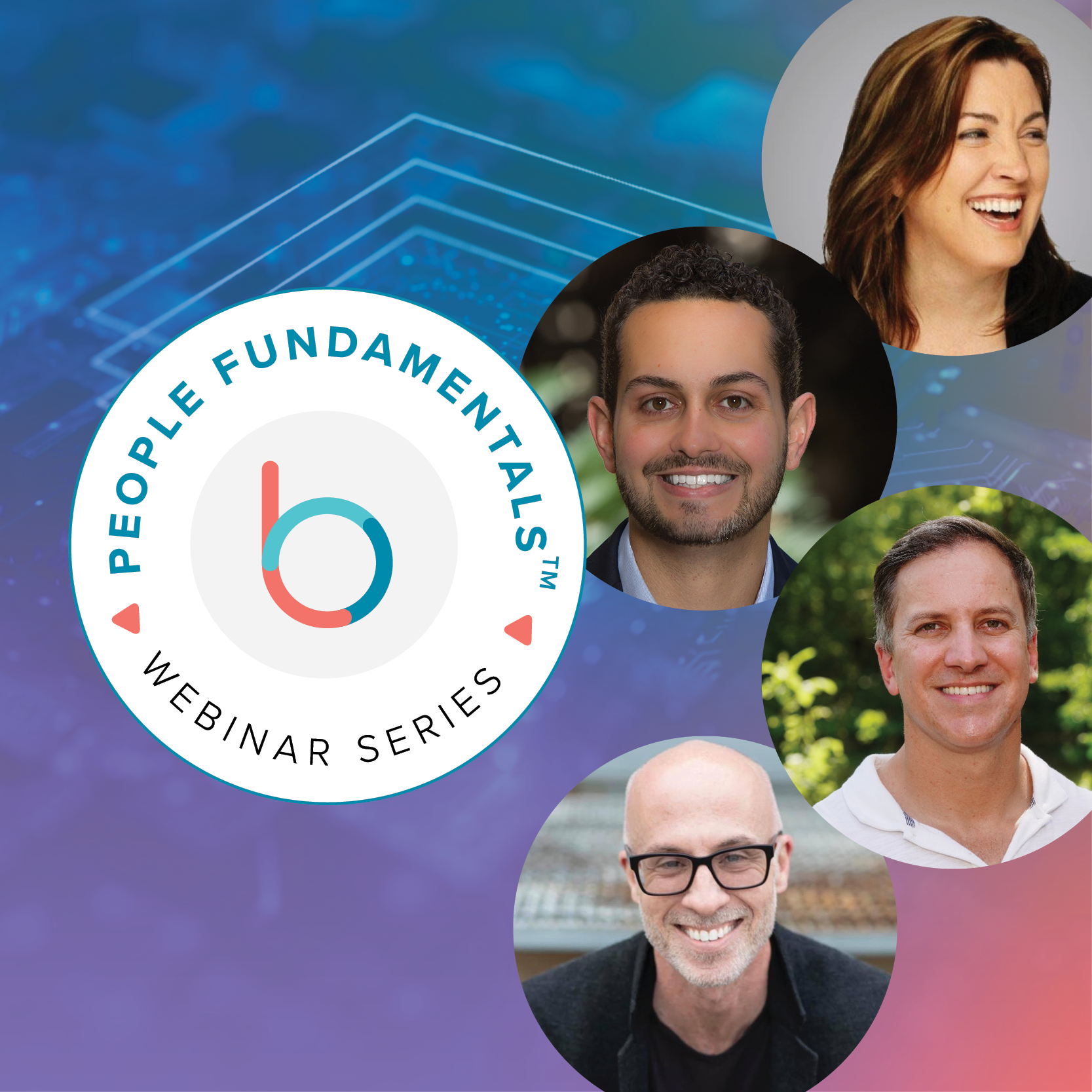An effective employee engagement strategy doesn’t begin and end with insightful survey questions. To truly drive engagement in an organization, it’s what HR and leadership do with the survey results that matters most.
For organizations either new to the concept of employee engagement or trying to overhaul an existing engagement strategy, one question almost always arises:
What do you do with employee engagement survey results?
To answer that question, we’re going to detail a seven-step process HR can use to maximize the benefits of an employee engagement survey. With these steps, an organization can ensure that it’s able to identify, quantify, and act upon employee feedback to drive positive change.
1. Thank Your Employees
So you’ve completed your first survey, maybe even a few, and must now figure out what to do with the data. Before you start going through the results and action planning, a simple initial step will help ensure future success with your engagement surveys – thanking your employees.
79% of employees cite a lack of appreciation when leaving an employer.
A simple thank you to the workers that took the survey, especially if it was voluntary, demonstrates that you appreciate them taking the time and effort to answer the questions. An email from your organization’s leadership, ideally the CEO, also goes a long way in expressing that appreciation. With 79% of employees citing a lack of appreciation as a key contributor to leaving an employer, it’s obviously in an organization’s best interest to extend a heartfelt thanks.
Also, including a brief explanation in the appreciation email of why the survey is so critical to both the individual employee and the organization as well as how you’ll use the survey data only further reinforces the importance of participation. Direct managers should also thank their employees for taking part in the survey, again discussing how the results can impact their roles within the organization.
2. Interpret & Analyze the Survey Results
The second of the seven steps is where the results begin to transform into positive action. Even in this age of big data, information in itself does little good unless it’s categorized into the most insightful segments possible. Therefore, your choice of engagement software/platform has a significant effect on your ability to accurately interpret and analyze the survey results.
An effective analytics platform can quickly identify your organization’s strengths and weaknesses. Rather than manually digging through the data, the right solution will help you focus the key problematic areas, letting you drill further down to get to the root of any issues. Segmenting data according to specific employee groups also helps reveal individuals, teams, or departments that might struggle in a particular area.
Employee Segments Are Essential
For instance, perhaps a recent survey scores overall communication at a 65% favorability rating, an acceptable score for most organizations and industries. However, after taking a closer look at specific employee segments, you see that the sales team scored communication at 95% but your engineering department only gave it 30% favorability. While the overall results might be acceptable, there are obviously issues with the way the organization or managers communicate with your engineers.
Using solutions with comprehensive reports and specific tools like heat mapping will help HR and leadership quickly identify these types of discrepancies in the results. There will always be areas for improvement, no matter how engaged your overall workforce might be. Ultimately, however, the ability to drill down and look for underlying issues within specific employee segments will continually drive greater engagement, performance, and productivity.
Data Analysis Best Practices
Aside from software-based tools, a few best practices will also help you transform your survey data into actionable insights.
- Before the survey, establish a small group of managers from a variety of departments to help HR create the most informative employee segments to gauge. This team-oriented approach will help ensure you’re maximizing the impact of the survey results.
- Establish a checklist for reviewing the results. This will provide a much-needed structure to help you interpret the data rather than randomly sorting through the information.
- When possible, have multiple people responsible for analyzing the results to integrate a broader range of perspectives.
3. Encourage Leadership & Management to Discuss & Communicate Results
This third step occurs at two separate levels – communicating and sharing survey results with other team leaders and managers, and sharing them with the company as a whole.
It’s essential for managers to understand what the data says about their own team dynamics.
Leaders & Managers
HR can encourage department heads and other leadership to look at the survey results from their own teams and employees. Afterward, they can meet with each manager to further discuss the results, what these mean for their team, and start assembling a course of action for change. This is a critical first step before presenting the survey results to the overall organization since it’s essential for managers to understand what the data says about their own team dynamics.
The Employees
Once leadership and management have pored over the survey results with HR, identified areas for improvement, and discussed possible courses of action, then it’s time to discuss the results with the workforce. It’s usually helpful to designate a single person to lead the communication, hitting highlights like sentiment analysis and satisfaction scores to give employees a broad overview.
Remember, the survey results tell a story involving factors like engagement, culture, employee satisfaction, and others. Survey results are most impactful when an employer provides their people with the narrative behind the results rather than just columns of raw data. Once the organization gives the complete story behind the survey results, its employees are far more likely to understand the bigger picture.
4. Encourage Managers to Conduct Team/Department Meetings
Building on the previous step, managers play a critical role in personalizing the survey results for their teams. Once the organization has shared an overview of the results and a summary of the road ahead, managers can then advance the conversation and explain what the data means for individuals and teams.
Smaller team or department meetings are especially important in larger organizations, where the sheer size of an employee base can make it easy for individuals to feel lost in the masses or feel unimportant in the bigger picture. By communicating survey results to team members through smaller groups, an organization can provide a more honed perspective.
Smaller team meetings and individual check-ins also allow managers to focus on how the data impacts their team’s day-to-day routine rather than speaking in generalities centered around the entire workforce. Using our previous example, the manager in the engineering department that scored 30% on communication can use a team meeting as an opportunity to have an in-depth, open conversation on the topic.
5. Make Decisions & Create Action Plans Based on Results
Once an employer has analyzed the data, shared it with managers and the workforce, and conducted team meetings on the results, it’s time to start more detailed action planning. If this is the organization’s first experience with an enterprise-wide survey on engagement, chances are the results will reveal several areas for improvement. To prevent diluting their efforts, it’s usually best for HR and managers to start small and build for the future, using an organized approach.
- From an organizational perspective, choose two or three areas to concentrate on first, often referred to as the low-hanging fruit. This will allow HR and leaders to focus their attention, time, and resources on getting some quick wins. Those wins can be instrumental in creating a sense of momentum going forward.
- Use follow-up pulse surveys and polls to drill down further into those two or three items to uncover the issues driving them. This allows HR to identify the underlying, often nuanced dynamics driving these issues that would otherwise remain concealed.
- More advanced engagement survey solutions will also make suggestions for action planning based on the survey results. However, whether action plans stem from the software, a committee of HR and managers, or both, start making decisions to put those plans in motion.
- For each plan, designate a lead person who will be responsible for checking progress against a timeline and milestones. If no one is held accountable for enacting change, it’s far less likely to occur.
- Document each action plan in writing. Be as specific as possible, using actual dates on the timeline rather than general time frames. However, this shouldn’t imply that the plans must be rigid and inflexible, especially when an organization is new to an employee engagement strategy. HR will be essential in this capacity, supervising the process and recognizing where it might need refinement. Transforming survey results into positive change is an acquired skill that an organization improves upon with time and repetition.
6. Communicate Actions
Transparency is one of the overarching goals of an engagement survey strategy. Employees are far more likely to be engaged with their work and the organization if they feel like they understand the motives behind decisions and, just as importantly, have a voice in the process. In fact, research shows that 82% of employees would still feel satisfied with their job, despite being underpaid, as long as they understood the reasons why. In other words, people don’t want to be held in the dark.
Transparency is one of the overarching goals of an engagement survey strategy.
In conjunction with the action planning, announce the organization’s goals to the workforce. This not only creates that critical sense of transparency, but also demonstrates to the employees that leadership is taking the survey results seriously. When workers see that the upper levels of the company take the survey data to heart – from the C-Suite down to department managers – it creates a groundswell that HR can build from.
After the first set of action plans are complete – or at least their initial stages if they are ongoing initiatives – an organization-wide meeting provides an excellent opportunity to present the impact of the engagement strategy. Look at the pre-survey metrics, compare them to the post-action plan results, and let the employees see why the survey questions and their participation is so pivotal to the organization and their roles within it. Tangible results propel engagement forward and foster the critical buy-in needed to transform the entire enterprise.
7. Follow-Up & Update
Improving engagement is an ongoing process that never has an endpoint. As an organization grows, so does the complexity of its operations and workforce. After sharing, action planning, and discussing the results of the first survey, use the data as a guide for subsequent surveys and pulse polls. Each new set of questions allow HR to drill further down into the issues within the workforce.
Also, continue to follow-up on the action plans, ensuring that the positive change they drive becomes a permanent fixture rather than a mere bandage over a wound. Likewise, as the engagement strategy evolves, it’s helpful to update employees on the continuing process, keeping everything fresh in their minds while also reinforcing transparency. If one of the action plans was the starting point to an extended initiative, keep the workforce apprised of the progress towards the underlying goals, continuing to hold managers accountable for that progress.
Employee engagement is critical for everything from company culture and vision to performance and productivity. An engagement survey strategy that integrates these seven steps will help your organization unlock the potential of its workforce and improve the employee experience, both now and for years to come.
Employee surveys are administered by companies in an effort to measure procedures, processes, company culture, management, and much more. They provide results that can be used for a number of beneficial things.
These results are important to employees as they provide an outlet to express their feelings, comments, and complaints. These types of surveys are best received when anonymous.
The first stage is to analyze the results among the management team. Here, managers may identify specific steps to take or make important pivots.
After the strategy has been created, it’s important to discuss the survey results with the employees who participated. Allow them to see exactly how their responses were used and how things will change because of it.
Different departments should always have different segments on employee surveys. The way in which the engineering team and the marketing team look at sales efforts will be based on entirely different perspectives.
These segments may be measured in different ways. While every answer is important, office culture will be more widely observed by in-house employees rather than front-line employees.







